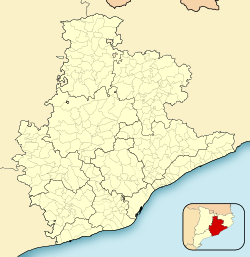Sant Joan Despí
| Sant Joan Despí | ||
|---|---|---|
| Municipality | ||

Torre de la Creu, or "the Egg House"
|
||
|
||
| Location in Catalonia | ||
| Coordinates: 41°22′05″N 2°03′29″E / 41.36806°N 2.05806°ECoordinates: 41°22′05″N 2°03′29″E / 41.36806°N 2.05806°E | ||
| Country |
|
|
| Community |
|
|
| Province | Barcelona | |
| Comarca | Baix Llobregat | |
| Government | ||
| • Mayor | Antoni Poveda Zapata (2015) (PSC-PSOE) | |
| Area | ||
| • Total | 6.2 km2 (2.4 sq mi) | |
| Elevation | 10 m (30 ft) | |
| Population (2014) | ||
| • Total | 32,981 | |
| • Density | 5,300/km2 (14,000/sq mi) | |
| Website | sjdespi |
|
Sant Joan Despí (Catalan pronunciation: [ˈsaɲ ʒuˈan dəsˈpi]) (Old Catalan for Saint John of the Pine) is a city and municipality located in the Baix Llobregat area (Barcelona province in Catalonia, Spain). It is situated on the left bank of the Llobregat river. Es is a dialectal form of the masculine article el, hence Despí would be rendered Del pi in standard Catalan.
Currently, Sant Joan Despí has 31,438 inhabitants divided into 5 very disaggregated districts. It also has an industrial quarter.
Barri Centre (Catalan for center quarter) is the original urban core of the town, formerly called Nucli antic (old town). The district is bounded by the railway, B-23 motorway, Cornellà de Llobregat and by the new Eixample district towards the Llobregat River. It is full of Art Deco buildings, many of them designed by Josep Maria Jujol who was the official town council architect from 1926. It also contains the oldest buildings of the town including Esglèsia de Sant Joan Batista (Saint John the Baptist Church) and a small medieval chapel. In the 1960s, this quarter was still a small set of cottages, where wealthy people from Barcelona spent their holidays, and small houses, but since then, urban spread has changed a lot substituting most of the houses with tall buildings and changing the green spaces into concrete parks. Nowadays you can still find some of the old small houses, and most of the singular ones but they are surrounded by modern buildings.
Les Planes (Catalan for the plains) is a district which appeared during the 1960s and the 1970s to house the incoming immigration from other Spanish regions specially Extremadura and Andalusia. Les Planes is separated from the center quarter by the Polígon Fontsanta industrial quarter and from the TV3 quarter by the Parc Fontsanta park and indeed, it is urbanistically continuous just towards the Padrò quarter of Cornellà de Llobregat.
...
Wikipedia



